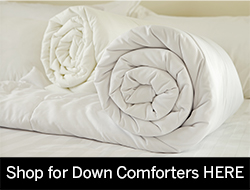How to stop Your Down Comforter from
Slipping Inside Your Duvet Cover.
Updated 1/2024
Occasionally people tell us that their down comforter moves around inside of their duvet cover. Although we don’t think this is a widespread issue, we do have a tip that can stop this from happening.
In the video below, we explain how to remedy this problem if this is driving you crazy.
Shop for our luxury down comforters below.
One of the reasons this occurs is when people get into bed, they will grab the duvet cover and pull it up to their face. If there is any gap between the comforter and duvet cover at the top edge, some have the tendency of only grabbing the duvet cover and pulling it up. This practice exacerbates the problem as the gap will continue to get larger over time.
Another thing that happens is, the duvet cover and down comforter fall off the foot of the bed, and gravity pulls the comforter further down the foot of the duvet cover. Down comforters don’t slip up, they slip down.
So here is the fix for around $1.00 in materials and 15 minutes.
Down comforter alteration:
- Find or buy a pair of shoelaces or find a couple of pieces of thin fabric that are 12” to 15” long and ½” wide.
- Cut the laces or fabric into 4 pieces, 2 that are 10” to 12” long and 2 that are 1 1/2” long.
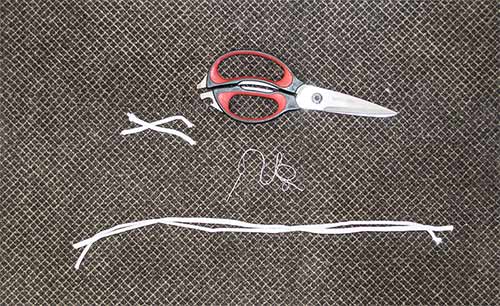
- Now sew the 2 ends of the strap to the corner of the comforter at a 45-degree angle as shown below. Repeat this process with the other top corner.
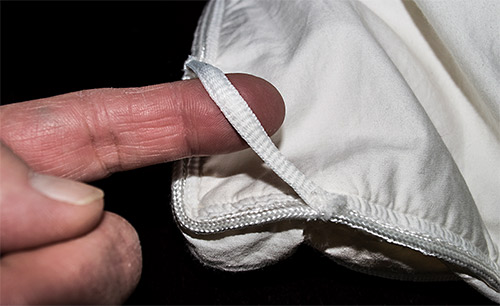
- Be very careful to sew them to the cord or an area outside of the compartments.
- If you don’t, the tension created by the weight of the comforter will over time, make the small needle hole larger and larger. This will allow the down to escape over time.
While you have the needle and thread out, consider doing this to all 4 corners.
- You will not need to secure the comforter at the foot of the duvet cover as stated before, they don’t slip up. But if you ever decide to rotate the comforter from head to foot, which is recommended as it evens out the wear (comforters wear out in the shoulder area).
Now onto the duvet cover:
- Reach your hand inside the duvet cover, and find the upper corner, grab it and bring the corner out of the envelope.
- Take one of the larger straps or laces and sew it at the middle to the corner of the duvet cover, as shown below.
- Repeat on the other corner. Again there is no need to sew ties at the foot of the duvet cover.
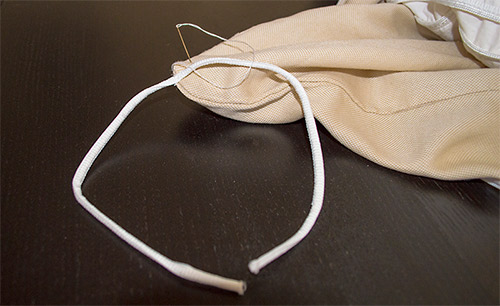
Attaching them:
- Slipping one end of the duvet straps under the straps of the duvet cover and tie it in a bow, as shown below.
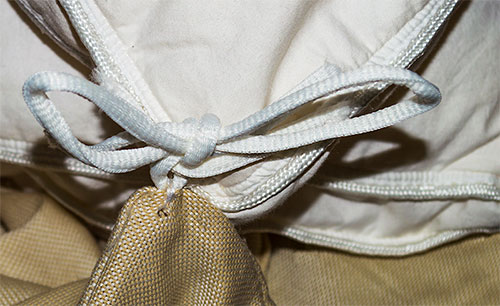
- Repeat this on the other corner.
- Pull the down comforter over the rest of the down comforter.
You're good to go!
You may also enjoy these articles:
- How to tell when it is time to replace your Down Comforter
- There is a difference between down & feather
- The Difference between a Duvet Cover and Down Comforter
- The Best Duvet Cover Construction Styles...
Down Comforter and Duvet Cover FAQ
What is the most popular style of down comforter?
- The box stitch is the most common style.
- A baffle box down comforter is the best style.
- Read our article on the different styles of down comforters here to learn the benefits of a baffle box over other styles sold on the market.
How should a down comforter be cleaned?
- Washing is the preferred method to clean one (vs. dry cleaning).
- Learn the best way to clean a down comforter in our article how to launder your down comforter here.
What is the best type of duvet cover?
- The best fabric to use for a duvet cover is a sheet weight cotton fabric.
- Read our article on what to look for in a duvet cover here.
How long do down comforters last?
- Between 10 to 15 years.
- Read our article on why they wear out and how to tell if your down comforter is worn out and needs replacing here.
Are comforters available with feather filling?
- We are not aware of an all feather comforter; they would be far too heavy.
- Down is a much better filling for a comforter as it is light, airy, and a much better insulator and other types of filling.
- Read our article on the difference between down and feather.
- Both feather and down are used in sleeping pillows.
- Feather or a feather/down combination creates a firmer pillow.
- Learn more about the various types of pillow fillings here. .

